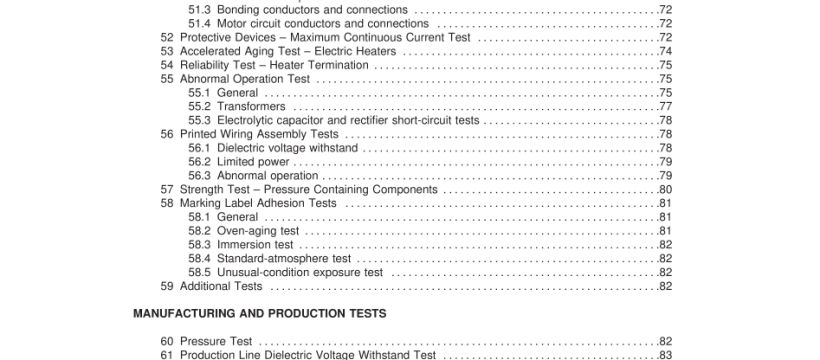UL 416-2008 pdf download.Refrigerated Medical Equipment.
3.1 1 LIMITED ENERGY CIRCUIT – A limited energy circuit is one in which the product and wiring is incapable of releasing sufficient electrical or thermal energy under normal or abnormal conditions to cause ignition of cotton in an oxygen-enriched atmosphere. Abnormal conditions include unintentional damage to any part of the equipment or wiring, failure of insulation or other failure of electrical components, application of overvoltage, adjustment and maintenance operations, and other similar conditions. 3.1 2 OPERATING CONTROL – A control, usually a knob, pushbutton, or lever, provided to enable the user to cause the product to perform its intended function, without the use of tools. 3.1 3 OPERATOR (USER) SERVICING – Any form of servicing that might be performed by personnel other than qualified service personnel. Some examples are: a) The attachment of accessories by means of attachment plugs and receptacles or by means of other separable connectors. b) The replacement of recording paper rolls, tapes, and similar items. c) Resetting of circuit breakers or replacement of tubes, fuses, and lamps that are accessible without the use of tools. d) Routine operating adjustments necessary to adapt the product for its different intended functions. e) Routine cleaning, changing of filters and pens, removal of blockages in tubing, and clearing of jams in data-recording media. 3.1 4 PATIENT-CONNECTED CIRCUITS – All patient connections, such as pads, contacts, probes, sensors, or cuffs applied to the patient and any associated leads, cables, components, or wiring either within or external to the product enclosure. As seen from the patient into the equipment, these circuits extend to the points where the required degree of isolation or protective impedance is reached.
3.1 9 REINFORCED INSULATION – Improved functional insulation with such mechanical and electrical qualities that it, in itself, provides the same degree of protection against electric shock as double insulation. 3.20 SAFETY CIRCUIT – Any circuit, either in the primary or secondary, that is relied upon to reduce a risk of fire, electric shock, or unintentional contact with moving parts that may cause injury to persons, for example, an interlock circuit is considered to be a safety circuit. 3.21 SECONDARY CIRCUITS – Secondary circuits are those circuits supplied from transformer output windings which are electrically separated from the input windings. 3.22 SUPPLEMENTARY (PROTECTIVE) INSULATION – An independent insulation provided in addition to the functional insulation to assure protection against electrical shock in case of failure of the functional insulation. 3.23 SUPPLY CIRCUIT – The branch circuit supplying electrical energy to the product. 3.24 TYPES OF EQUIPMENT – Recognizing the differences in applications to the patient and in the degree of risk posed by electrical equipment in various areas of a health care facility, i.e., professional office, clinic, hospital, or laboratory, refrigerated medical equipment covered by this Standard is treated as follows: a) Patient Care Equipment – Equipment intended to be used on or with, or likely to be contacted by, a patient in a health care facility in the course of his treatment. b) Nonpatient Equipment – Equipment for use in a health care facility and for use where contact with a patient is unlikely. 3.25 ULTIMATE STRENGTH – The highest stress level which a refrigerant-containing component can tolerate without rupture.
5.2 A product shall be constructed so that it can be cleaned or sterilized in accordance with the manufacturer’s instructions, see Installation and Operating Instructions, without affecting the application, operation, and performance of the product. One sample of the product, or appropriate portion of the sample if it is intended to be only partially cleaned or sterilized, shall be subjected to the Cleaning and Sterilization Test if it is not obvious that the product complies with this requirement. 5.3 Carrying handles or grips furnished on a portable product shall withstand loading as described in 44.1 . The handles shall not break loose from the product and there shall be no permanent distortion, cracking, or other evidence of failure. 5.4 Mounting brackets on a product intended to be wall or ceiling mounted shall withstand loading as described in 44.2 without evidence of damage to the brackets or mounting surface. 5.5 Unless an investigation shows the circuits to be energy limited as defined in 3.1 1 , all electrical components shall be separated from oxygen-enriched atmospheres. An oxygen-enriched atmosphere is considered to exist if the oxygen concentration exceeds 21 percent by volume.UL 416-2008 pdf download.
UL 416-2008 pdf download
